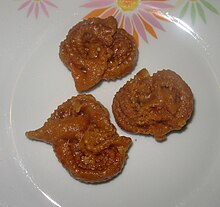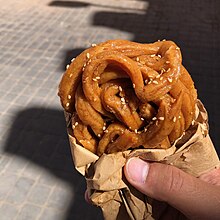Chebakia
 | |
| Type | Dessert |
|---|---|
| Place of origin | Ottoman Empire |
| Region or state | Maghreb |
| Main ingredients | dough, honey and orange blossom water |
Shebakia (Arabic: شباكية) or Chebakia, also known as Griwech or Griouech, is a Maghrebi pastry made of strips of dough rolled to resemble a rose, deep-fried until golden, then coated with a syrup made of honey and orange blossom water and sprinkled with sesame.[1][2][3] It is typically consumed during Ramadan and religious celebrations.[1][4] Chebakia is from the Ottoman desserts culture.[5]
Chebakia is made using yeast spiced with anise, cinnamon, and saffron.[6] The dough is made from ground sesame seeds mixed with flour and maybe squeezed through a pastry tube or twisted by hand to achieve the flower-like shape.[6][7] It is then fried like a donut. The pastry is often produced in large batches at the start of Ramadan.[8][6] Although it is sweet and is often paired with coffee and tea, Moroccans also eat chebakia with spicy food such as harira.[6]


Similar pastries include the Cartellate and the Fazuelos, though the latter are constructed differently, and are thinner, less dense and from different regions.
Names and origin
[edit]Etymology
[edit]The names of Chebbakia, and its size, shape and exact ingredient may vary by region. In Algeria[1] and in Fez, Morocco, it's known as griwech (Moroccan Arabic: ڭريوش or Algerian Arabic: قريوش). In Rabat, as mkherqa (مخرقة). In Salé, as El-qli (القلي). In Ouezzane as lahlou (الحلو), and in some other Moroccan region as kliwech (كليوش).[9][10]
History
[edit]The origin of this pastry is likely Ottoman, due to its similarity to Eastern pastries such as baklawa in former Ottoman areas, and meshbek in Syria also known as zalabiyeh.[11]
In Morocco, a folk origin story claims that chebbakia was invented by an ambulant pastry merchant, who fell in love with a beautiful girl he saw every day at her window, and decided to make honeyed pastries in the shape of her window (Arabic: شباك, shubbak), to give her as a gift.[11]
See also
[edit]References
[edit]- ^ a b c Benayoun, Mike (1 Jul 2016). "Griouech". 196 flavors. Retrieved 13 Nov 2022.
- ^ Mom, LDS's (3 Sep 2018). "Algerian Crunchy Sweets- Griwech". My Excellent Degustations. Retrieved 13 Nov 2022.
- ^ "about.com". Archived from the original on 2017-02-08. Retrieved 2014-04-24.
- ^ "Moroccan Sesame and Honey Cookies With Saffron, Cinnamon and Anise". The Spruce Eats. Retrieved 2021-11-09.
- ^ Oktay, S. and Sadıkoglu, S., 2018. Journal of Ethnic Foods. p.6.
- ^ a b c d Sheen, Barbara (2011). Foods of Morocco. Farmington Hills, MI: Greenhaven Publishing LLC. p. 44. ISBN 978-0-7377-5865-8.
- ^ Newton, James (2012). Moroccan Cookbook - Moroc Cuisine. Springwood emedia. pp. 93–94. ISBN 978-1-4760-7547-1.
- ^ Lonely Planet's Ultimate Eats: The world's top 500 food experiences...ranked!. Lonely Planet Food. 2018. ISBN 978-1-78701-977-5.
- ^ "الشباكية". 12 June 2022. Retrieved 2023-07-01.
- ^ Benkabbou, Nargisse (2018). Casablanca: My Moroccan Food. Octopus. ISBN 9781784725105.
- ^ a b "أصولها عثمانية ووصلت إلى المغرب عن طريق الجزائر.. "الشباكية"، أشهر الحلويات الرمضانية المغربية" [Its origin is Ottoman and it arrived to Morocco through Algeria]. 2023-03-16. Retrieved 2023-07-01.
External links
[edit]- "Chebakia (Chebbakia, Halwa Shebakia, Mkharka) - Recipe for Fried Moroccan Sesame Cookies with Honey". About.com Moroccan Food. Archived from the original on 2017-02-08. Retrieved 2014-04-24.
- כהן, רפי (25 February 2010). "המתוקות הראשונות: משלוח מנות חגיגי". ynet. Retrieved 2014-04-24.

